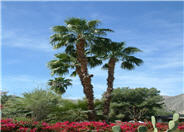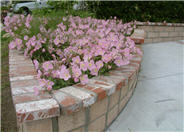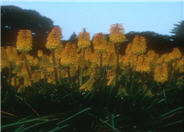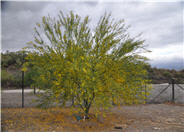
Common name:Mexican Fan Palm
Botanical name:Washingtonia robusta
The Mexican Fan Palm is a very tall, rapidly growing palm with large, fan-shaped leaves. It has a tropical look, and can grow several feet a year. This species is excellent for larger gardens and lining streets and avenues.

Common name:Pink Mexican Evening Primrose
Botanical name:Oenothera speciosa 'Rosea'
Oenothera speciosa 'Rosea' is a perennial groundcover. It grows 10"-12" high, with profuse showing of 1.5" wide rose pink blooms in summer. Flowers open in daytime and stems die back after bloom. It can be highly invasive.

Common name:Torch Lily Improved
Botanical name:Kniphofia hybrids
This perennial will grow to about 6' tall and has large green, grass-like leaves with red, orange, and yellow tubular flowers that bloom in summer. Flowers resemble tiki torches. Hummingbirds love the flowers.

Common name:Indian Hawthorne or Rhaph
Botanical name:Rhaphiolepis indica
This small shrub will grow 2' tall and 4' wide. It has small, dark green leaves that get a red tint in the winter and deep pink flowers that bloom fall through spring.

Common name:Mexican Palo Verde, Jerusalem Thorn
Botanical name:Parkinsonia aculeata
The Mexican Palo Verde has prickly stems. This tree is very fast growing with sparse foliage and very long narrow leaves. Yellow flowers with orange red throats bloom sporadically. It is very messy, thorny, weedy and short-lived. This tree is usually found on limestone soils in areas with moisture but is strongly drought tolerant. It can withstand saline conditions. It can be cold or drought deciduous. It is beautiful in form being light and airy looking, with green bark.
| Designer: CLWA | Shelter Area |
Photographer: GardenSoft |
Soils and Compost:
Incorporate compost 6" into your soil to retain water, reduce compaction, feed earthworms, and provide valuable nutrients to your plants.
Water Saving Tip:
Replace turf with groundcovers, trees, and shrubs. If you have areas where no one uses the grass, patches that do not grow well, or a turf area too small to water without runoff, consider replacing the turf with water-efficient landscaping.
Integrated Pest Management:
Drip and other smart irrigation delivers water directly to roots, allowing no excess water for weeds.

